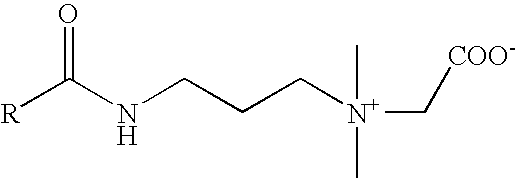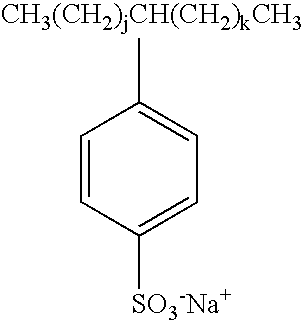Method for measuring octanol-water distribution coefficients of surfactants
- Summary
- Abstract
- Description
- Claims
- Application Information
AI Technical Summary
Problems solved by technology
Method used
Image
Examples
example 1
[0057]Substance: C22-amidoamine betaine. The major component of the C-chain distribution is C22-alkenyl.
[0058]Equilibration experiment: 100 mL of a 1 g / L aqueous solution of the surfactant and 100 mL octanol were placed in a conical flask. The two-phase system was stirred for eight hours on a magnetic stirrer. The stirring speed (100 rpm) was low enough for there to be two distinct layers. After the stirrer was switched off, the system was allowed to stand overnight. Then a 2 mL sample of the aqueous phase was placed in a tensiometer glass and evaporated to dryness in a drying cabinet. The residue was redissolved in 50 mL of 0.2 M KCl. The surface tension of this solution was measured with the Pt plate method. The solution was then diluted five times with 0.2 M KCl and the surface tension measured again. The concentration of surfactant was determined by comparison with a calibration curve. A duplicate experiment was run to check the reproducibility.
[0059]FIG. 2 shows the calibration...
example 2
[0062]Substance: C10-C13 linear alkylbenzene sulfonate (LAS).
[0063]Equilibration experiment: 100 mL of a 1 g / L aqueous solution of the surfactant and 100 mL octanol were placed in a conical flask. The two-phase system was stirred for eight hours on a magnetic stirrer. The stirring speed (100 rpm) was low enough for there to be two distinct layers. After the stirrer was switched off, the system was allowed to stand overnight. Then a 2 mL sample of the aqueous phase was placed in a tensiometer glass evaporated to dryness in a drying cabinet. The residue was redissolved in 50 mL of 0.2 M KCl. The surface tension of this solution was measured with the Pt plate method. The concentration of surfactant was determined by comparison with a calibration curve.
[0064]An experimental determination of the critical micelle concentration with the surface tension method gave a value of 1.0 g / L in demineralised water. Literature data (Jonsson et al. in Christian+Scamehorn (editiors), Surf. Sci. Ser. 5...
PUM
 Login to View More
Login to View More Abstract
Description
Claims
Application Information
 Login to View More
Login to View More - R&D
- Intellectual Property
- Life Sciences
- Materials
- Tech Scout
- Unparalleled Data Quality
- Higher Quality Content
- 60% Fewer Hallucinations
Browse by: Latest US Patents, China's latest patents, Technical Efficacy Thesaurus, Application Domain, Technology Topic, Popular Technical Reports.
© 2025 PatSnap. All rights reserved.Legal|Privacy policy|Modern Slavery Act Transparency Statement|Sitemap|About US| Contact US: help@patsnap.com


